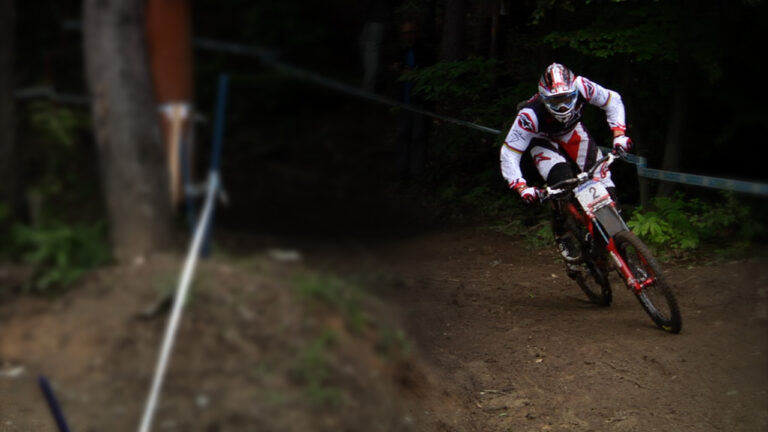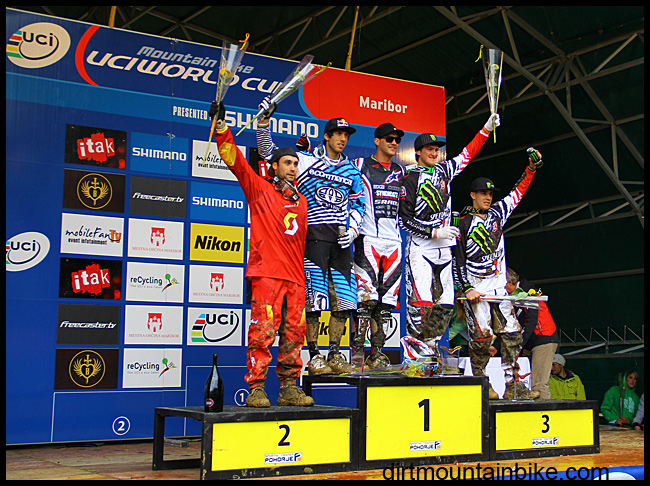Hot on the heals of last weeks wide bar debate Morgan Hampton shares his thoughts on UK 4X tracks in a feature we are now calling “Tuesday’s Can o’ Wasps”
Have a read and tell us what you think in the comments below, try and make it constructive-last time it descended to the point of Jesus and Buddha offering each other outside for a fight.
UK 4X Tracks – Just where are we to go?
Ok, so here we ago again. Another Tuesday, another bit of ranting. This week I’ll be concentrating my aim on UK 4X; namely the tracks that are used, and just what constitutes as “proper” 4X. Thanks to Pete Newman for the photos. He just wanted me to make it clear that he won’t necessarily agree with what I’m saying here; so don’t hate him if you don’t like what’s written.
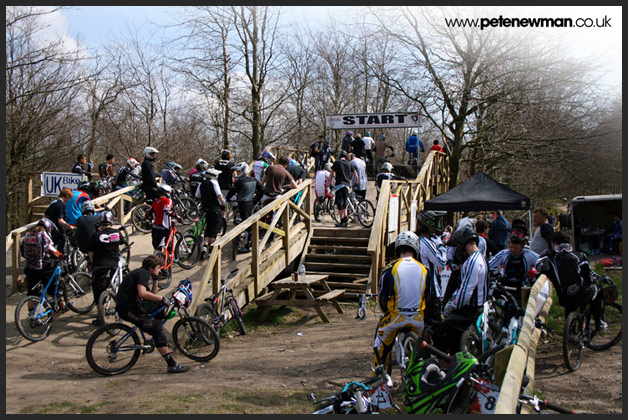
After the 2009 WC season there was a lot of talk about how good the 4X coverage was on Freecaster. I, like hundreds of others tuned in to watch the greatest 4X riders in the world go head to head over a real mixture of tracks. Exciting it certainly was, but it was not without criticism. This in turn led to many discussions as to what a 4X track should be, and in turn, what the tracks in the UK are like.
There are some who say that UK tracks are too smooth, more akin to BMX tracks. They are calling for rougher tracks to be built, so we’d have more for our WC riders to train on. The way I see it is that a lot of the WC tracks are too much like rough BMX tracks, and don’t always allow for good racing.
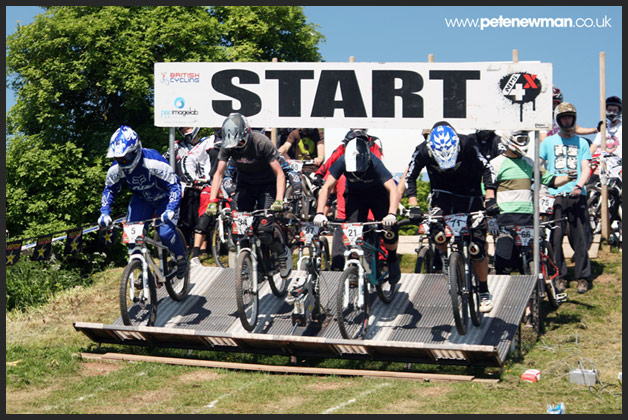
4X is still in its infancy when compared to BMX. It was started in the UK by a bearded man with a vision, on a hillside on the edge of the Cotswold’s. Graham Foot was the man with that vision, and he took the existing concepts of Duel (two men one track) and Dual (two men two tracks) added some mad features (car jump anyone?), and came out with Bicycle Super Cross (BSX) which was the birth of 4X. The original track, now sadly gone, was a cocktail of multi line chaos. And when I say multi line I don’t mean huge sweeping berms with about a million entrance and exit points, there were literally loads of individual lanes. Sometimes the track would be full width, then it would split into two different lines around a corner, over a jump, full width over another jump, then three lanes of almost single-track width, then rejoining to full width but split in half with different size features. I never raced BSX there, but I got to watch some of the races. They were brilliant, with massive amounts of overtaking, switching lines, big jumps and chicken runs, crashes, more passing, and the occasional trick thrown in for a laugh. Although the track was rough stone surface, it was on the whole smooth to ride – best suited to a small chuckable hardtail. I’m sure there was some footage on one of the old Sprung videos if you want to check it out. Or if anyone has a link to some footage please post it below.
Far removed from modern 4X tracks it would seem. Nowadays it seems that most 4X races can be summed up in the following way:
Riders ready, watch the gate, beepbeepbeepbeeeep, sprint, pump, sprint, jump, sprint, sprint, sprint some more, first corner, the end.
Which is a shame really, considering the potential for excitement that 4X offers. OK, that’s not strictly true. Racing 4X is bloody exciting. Watching it at a lot of tracks is pretty boring. “So and so’s got the snap, and they’ve won.” Watching 4X is like buying a lottery ticket in that you know the outcome won’t surprise you, but there’s always a tiny chance something could happen.
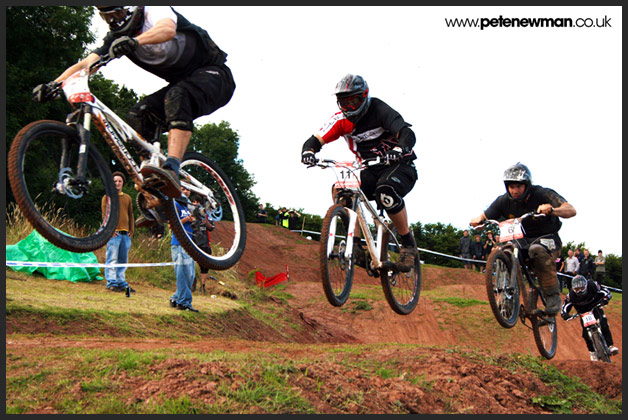
I’ll concede this is quite a sceptical view, but I think it’s quite accurate in most cases. I’m not in any way shape or form trying to slag off those who build tracks, nor the people who race them. Having helped build one I know how much work goes into it, and that it’s never perfect. It can always be bettered in some way. And someone will always moan no matter what. More often than not these are the people who never offer to help, don’t turn up to dig days, leave rubbish after races, and try to avoid paying to ride anyway. They are best ignored, or beaten with a spade.
4X is evolving, and so are the tracks. And judging by the 2009 season, both in the UK and on the WC circuit, the evolution is for the better. The tracks used for the 2009 WC showed that 4X doesn’t have to be all about the gate, nor does it have to be about massive rock gardens, and huge drops. Clever use of logs and steps inside corners, smaller but more technical rock gardens to slow the pace, off camber wet grass, pro sections and split lanes really helped keep the racing varied and exciting. I think Schladming was brilliant, and a real testament to where 4X should be heading. My only criticism? The twin line corner near the end was too wide, negating the multi line it was supposed to offer. Other than that it was amazing, and the racing was brilliant as a result. Whereas in the past, a track like Vigo , while having the huge rocks and drops that people claimed were needed, was a follow the leader series of crashes and falls. While You’ve Been Framed might have loved the footage, the racing wasn’t too brilliant, nor was it a true representation of who was the fastest rider; more the luckiest.
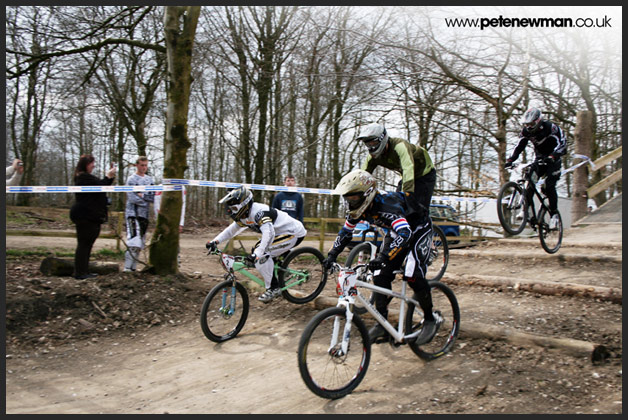
In the UK there are a limited number of tracks. What’s more, most of them are not specific race tracks at all. Bridgnorth is mainly used by Mountain Boarders for a start, UK Bikepark is mainly ridden by DH and Freeriders it would seem, and PORC has hardly been ridden by anybody until recently! For most of the year these independently owned/run tracks are used by all members of the paying public, by riders of all abilities. It’s one thing to suggest throwing in six foot drops, rock gardens, and thirty foot doubles, but if it isn’t rideable by all abilities it quickly looses paying customers, and thus become too expensive to justify running. Still, no matter how much I explain this to Steve “the Butcher” (Dirt Magazine Midland correspondent) he won’t stop telling me to build a massive rock garden at Redhill so he can feel smug about riding a full suss bike. Any excuse old man!
This is why some of you may have seen my comments about Afan 4X track, namely “does the UK really need a rough WC 4X track?” I mean, we’re producing some pretty damn good 4X riders right here on our smooth BMX-like tracks anyway. If all 4X tracks were WC standard where would you start? Would Little Johnny feel comfortable being a passenger on his standard hardtail through a brutal rock garden every weekend? Would he enjoy being laughed at every time he has to get off and push around a ten metre gap? Of course not. So by having smooth tracks that can be rolled by beginners or jumped by more experienced riders, we’re ensuring a future legacy of 4X. Both for young riders full of enthusiasm to emulate their heroes and older riders keen to get a buzz outside of their mortgage and marriage. If potential WC 4X riders want to practice they’re better off riding some hardtail DH in the woods, or get down the BMX track for gates, rather than moaning about a lack of WC standard tracks in the UK .
All this said, I’m not against tracks like Afan, or Hart Hill in Cheshire. Like I said, 4X is evolving, and with any luck these tracks will prove to be the bridge for many riders between a council built BMX/pump track and a full on WC track. The same logic can be applied to DH tracks. The proliferation of UK Trail Centres has led to a marked increase in gravity led riding. The next step from these slithers of steep singletrack is an uplift day at Cwmcarn, upgrading the Trance to an SX Trail then a weekend at FT Bill, followed by purchasing a full on DH rig and a fortnight in the Alps.
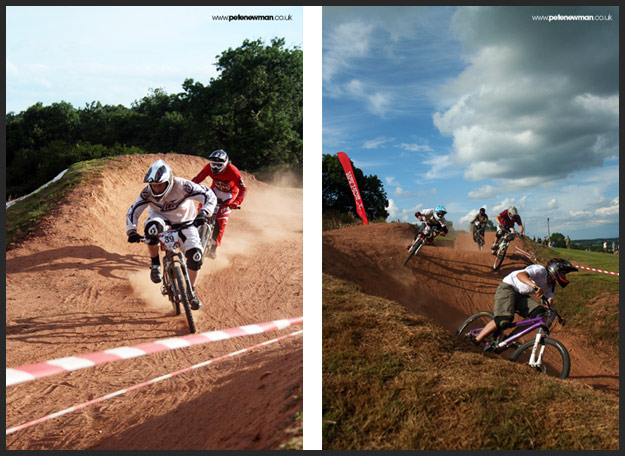
So then, back to the actual tracks in the UK. Most races on the tracks used are won within the first few metres, especially at higher levels where riders don’t make as many mistakes. Some tracks may have one cool tricky feature that either catches people out, or allows for a pass to be made. The inspired final 180 flat corner with inside logs at Chicksands is a perfect example of such a feature. Other than these features it’s usually a procession from start to finish. I’d like to think Redhill differs in that it offers room to pass nearly all the way down the track. Split lanes and multi lines mean it’s a fight for the race winning run. And it’s tight, so there’s no slacking off and waiting for the leader to cock up as you see in WC and BMX races. To win you’ve got to really get stuck in, stick close to the rider next to you, and show no mercy. If you don’t get the line you wanted, you’re left fighting off the ones whose line you’ve just been forced into. It’s not perfect, it’s always evolving, but I believe it offers the best racing in the UK so far.
As it stands most start sprints are about the rider who has inside lane choice. You’ll only get past them by having more power and a better gate. And the rider who’s chosen the inside lane usually has the most power and the best gate thanks to the way qualifying is run. Tracks need to take emphasis away from the gate start and the first corner. Some people have already said that putting more features in the first straight closer together would negate the power of the sprint. If the start ramp led to a series of features that were near impossibly to pedal smoothly through then a riders ability to generate pump and carry speed would be more important than freakishly large quads of steel. Having a first corner where the quicker inside line leads directly into a considerably slower section would make riders choose their line on the move, relative to where other riders are around them. Maybe just making the first straight super short, into a series of linked corners would make it more equal.
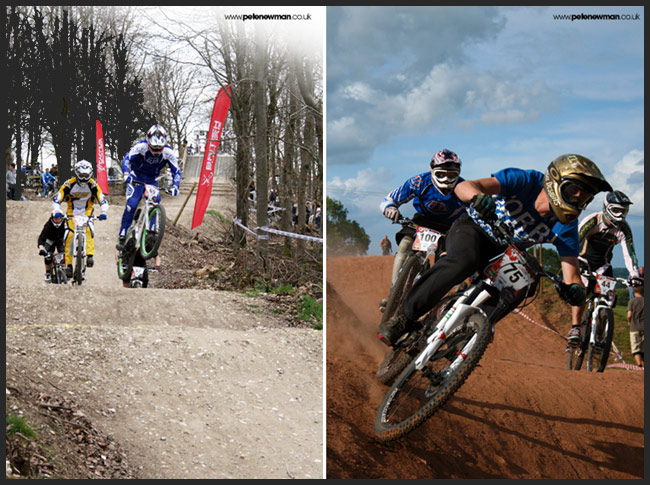
In my opinion I don’t think racing will be massively improved by huge jumps, massive drops and gnarly rock gardens, I think it’ll make it more inaccessible to newer riders and ultimately kill itself off. Instead I think the future lies in split lanes, less room to sprint between features, technical features that slow racing right up and cause bunching of riders and forced mistakes, and more emphasis on accuracy rather than being able to pedal your way out of any mistakes.
It’s a lot to ask of a track, and I know through hard graft and experience that it’s hard to achieve. That’s why I’ll be helping out at Afan on the upcoming dig days, and it’s why I get pissed off when non diggers suggest we totally change certain bits of Redhill 4X. It’s why I’m so excited to see all the constructive criticism that’s been taken onboard and put into practice with the massive changes at SW Extreme this year.
It’s also why I don’t agree with people who say tracks should represent the mountains we ride mountain bikes on. I’m still of the old school thinking that we ride ATBs (All Terrain Bikes for the youth out there), and as a track shouldn’t necessitate the use of a full suss bike, let alone an expensive dedicated race machine. One comment on the Afan 4X news feed said “a proper 4x track is one that actually justifies spending hundreds of pounds on a good fork for racing and using it on terrain other than smooth tracks”.
I couldn’t disagree more. Firstly, nothing can justify the cost of some modern forks. And secondly no track should justify having to spend large amounts of money just to ride it well. It’s the rider, not the bike that wins the race. That’s one of the best things about UK 4X; it’s open to so many more people than DH racing, and it’s not prone to the elitist bike snobbery either. It’s not about having the best forks or the newest helmet. It’s not about the progressive leverage ratio or the slackest head angle. It’s not about the pro replica bike or the cut down wet tyres. It’s not about split times or blaming yourself for that mistake on the wet root section. It’s about a large group of riders, friends, family, mixed up and head to head, no excuses, all trying to cross the line first, all having a good time.

Let’s not change UK 4X, let’s help it evolve.
Morgan Hampton
(the views contained above do not represent those of Redhill, its locals, its owner, it’s customers, or anyone else other than me)


